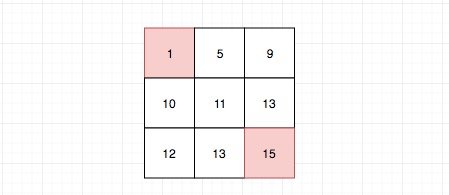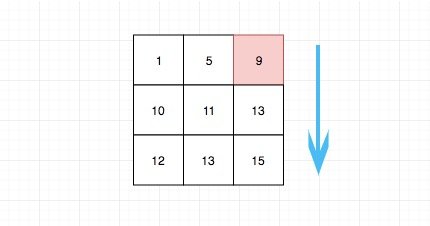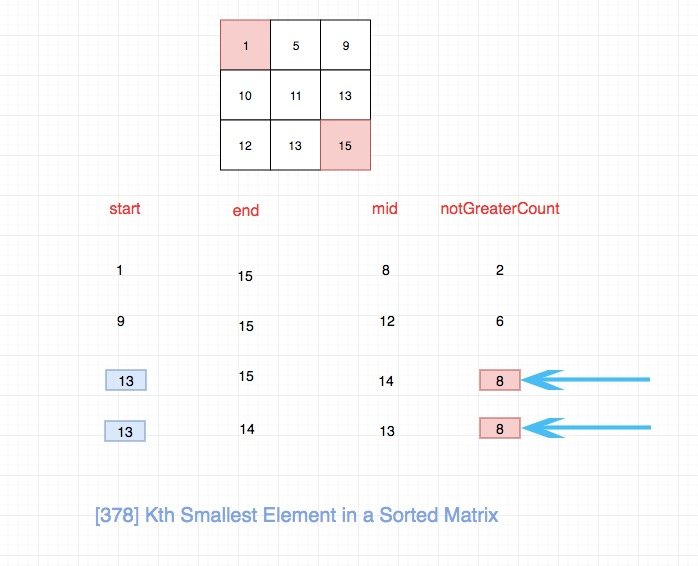# 0378. 有序矩陣中第K小的元素
## 題目地址(378. 有序矩陣中第K小的元素)
<https://leetcode-cn.com/problems/kth-smallest-element-in-a-sorted-matrix/>
## 題目描述
```
<pre class="calibre18">```
給定一個 n x n 矩陣,其中每行和每列元素均按升序排序,找到矩陣中第 k 小的元素。
請注意,它是排序后的第 k 小元素,而不是第 k 個不同的元素。
示例:
matrix = [
[ 1, 5, 9],
[10, 11, 13],
[12, 13, 15]
],
k = 8,
返回 13。
提示:
你可以假設 k 的值永遠是有效的,1 ≤ k ≤ n2 。
```
```
## 前置知識
- 二分查找
- 堆
## 公司
- 阿里
- 騰訊
- 字節
## 思路
顯然用大頂堆可以解決,時間復雜度 Klogn n 為總的數字個數, 但是這種做法沒有利用題目中 sorted matrix 的特點,因此不是一種好的做法.
一個巧妙的方法是二分法,我們分別從第一個和最后一個向中間進行掃描,并且計算出中間的數值與數組中的進行比較, 可以通過計算中間值在這個數組中排多少位,然后得到比中間值小的或者大的數字有多少個,然后與 k 進行比較,如果比 k 小則說明中間值太小了,則向后移動,否則向前移動。
這個題目的二分確實很難想,我們來一步一步解釋。
最普通的二分法是有序數組中查找指定值(或者說滿足某個條件的值)。由于是有序的,我們可以根據索引關系來確定大小關系, 因此這種思路比較直接,但是對于這道題目索引大小和數字大小沒有直接的關系,因此這種二分思想就行不通了。

(普通的基于索引判斷的二分法)
- 我們能夠找到矩陣中最大的元素(右下角)和最小的元素(左上角)。我們可以求出值的中間,而不是上面那種普通二分法的索引的中間。

- 找到中間值之后,我們可以拿這個值去計算有多少元素是小于等于它的。 具體方式就是比較行的最后一列,如果中間值比最后一列大,說明中間元素肯定大于這一行的所有元素。 否則我們從后往前遍歷直到不大于。

- 上一步我們會計算一個count,我們拿這個count和k進行比較
- 如果count小于k,說明我們選擇的中間值太小了,肯定不符合條件,我們需要調整左區間為mid + 1
- 如果count大于k,說明我們選擇的中間值正好或者太大了。我們調整右區間 mid
> 由于count大于k 也可能我們選擇的值是正好的, 因此這里不能調整為mid - 1, 否則可能會得不到結果
- 最后直接返回start, end, 或者 mid都可以,因此三者最終會收斂到矩陣中的一個元素,這個元素也正是我們要找的元素。
整個計算過程是這樣的:

這里有一個大家普遍都比較疑惑的點,也是我當初非常疑惑,困擾我很久的點, leetcode評論區也有很多人來問,就是“能夠確保最終我們找到的元素一定在矩陣中么?”
答案是可以, `相等的時候一定在matrix里面。 因為原問題一定有解,找下界使得start不斷的逼近于真實的元素`.
我是看了評論區一個大神的評論才明白的,以下是[@GabrielaSong](https://leetcode.com/gabrielasong/)的評論原文:
```
<pre class="calibre18">```
The lo we returned is guaranteed to be an element in the matrix is because:
Let us assume element m is the kth smallest number in the matrix, and x is the number of element m in the matrix.
When we are about to reach convergence, if mid=m-1, its count value (the number of elements which are <= mid) would be k-x,
so we would set lo as (m-1)+1=m, in this case the hi will finally reach lo;
and if mid=m+1, its count value would be k+x-1, so we would set hi as m+1, in this case the lo will finally reach m.
To sum up, because the number lo found by binary search find is exactly the element which has k number of elements in the matrix that are <= lo,
The equal sign guarantees there exists and only exists one number in range satisfying this condition.
So lo must be the only element satisfying this element in the matrix.
```
```
更多解釋,可以參考[leetcode discuss](https://leetcode.com/problems/kth-smallest-element-in-a-sorted-matrix/discuss/85173/Share-my-thoughts-and-Clean-Java-Code)
> 如果是普通的二分查找,我們是基于索引去找,因此不會有這個問題。
## 關鍵點解析
- 二分查找
- 有序矩陣的套路(文章末尾還有一道有序矩陣的題目)
- 堆(優先級隊列)
## 代碼
```
<pre class="calibre18">```
<span class="hljs-title">/*
* @lc app=leetcode id=378 lang=javascript
*
* [378] Kth Smallest Element in a Sorted Matrix
*/</span>
<span class="hljs-function"><span class="hljs-keyword">function</span> <span class="hljs-title">notGreaterCount</span>(<span class="hljs-params">matrix, target</span>) </span>{
<span class="hljs-title">// 等價于在matrix 中搜索mid,搜索的過程中利用有序的性質記錄比mid小的元素個數</span>
<span class="hljs-title">// 我們選擇左下角,作為開始元素</span>
<span class="hljs-keyword">let</span> curRow = <span class="hljs-params">0</span>;
<span class="hljs-title">// 多少列</span>
<span class="hljs-keyword">const</span> COL_COUNT = matrix[<span class="hljs-params">0</span>].length;
<span class="hljs-title">// 最后一列的索引</span>
<span class="hljs-keyword">const</span> LAST_COL = COL_COUNT - <span class="hljs-params">1</span>;
<span class="hljs-keyword">let</span> res = <span class="hljs-params">0</span>;
<span class="hljs-keyword">while</span> (curRow < matrix.length) {
<span class="hljs-title">// 比較最后一列的數據和target的大小</span>
<span class="hljs-keyword">if</span> (matrix[curRow][LAST_COL] < target) {
res += COL_COUNT;
} <span class="hljs-keyword">else</span> {
<span class="hljs-keyword">let</span> i = COL_COUNT - <span class="hljs-params">1</span>;
<span class="hljs-keyword">while</span> (i < COL_COUNT && matrix[curRow][i] > target) {
i--;
}
<span class="hljs-title">// 注意這里要加1</span>
res += i + <span class="hljs-params">1</span>;
}
curRow++;
}
<span class="hljs-keyword">return</span> res;
}
<span class="hljs-title">/**
* @param {number[][]} matrix
* @param {number} k
* @return {number}
*/</span>
<span class="hljs-keyword">var</span> kthSmallest = <span class="hljs-function"><span class="hljs-keyword">function</span>(<span class="hljs-params">matrix, k</span>) </span>{
<span class="hljs-keyword">if</span> (matrix.length < <span class="hljs-params">1</span>) <span class="hljs-keyword">return</span> <span class="hljs-params">null</span>;
<span class="hljs-keyword">let</span> start = matrix[<span class="hljs-params">0</span>][<span class="hljs-params">0</span>];
<span class="hljs-keyword">let</span> end = matrix[matrix.length - <span class="hljs-params">1</span>][matrix[<span class="hljs-params">0</span>].length - <span class="hljs-params">1</span>];
<span class="hljs-keyword">while</span> (start < end) {
<span class="hljs-keyword">const</span> mid = start + ((end - start) >> <span class="hljs-params">1</span>);
<span class="hljs-keyword">const</span> count = notGreaterCount(matrix, mid);
<span class="hljs-keyword">if</span> (count < k) start = mid + <span class="hljs-params">1</span>;
<span class="hljs-keyword">else</span> end = mid;
}
<span class="hljs-title">// 返回start,mid, end 都一樣</span>
<span class="hljs-keyword">return</span> start;
};
```
```
**復雜度分析**
- 時間復雜度:二分查找進行次數為 O(log(r?l))O(log(r-l))O(log(r?l)),每次操作時間復雜度為 O(n),因此總的時間復雜度為 O(nlog(r?l))O(nlog(r-l))O(nlog(r?l))。
- 空間復雜度:O(1)O(1)O(1)。
## 相關題目
- [240.search-a-2-d-matrix-ii](240.search-a-2-d-matrix-ii.html)
大家對此有何看法,歡迎給我留言,我有時間都會一一查看回答。更多算法套路可以訪問我的 LeetCode 題解倉庫:<https://github.com/azl397985856/leetcode> 。 目前已經 37K star 啦。 大家也可以關注我的公眾號《力扣加加》帶你啃下算法這塊硬骨頭。 
- Introduction
- 第一章 - 算法專題
- 數據結構
- 基礎算法
- 二叉樹的遍歷
- 動態規劃
- 哈夫曼編碼和游程編碼
- 布隆過濾器
- 字符串問題
- 前綴樹專題
- 《貪婪策略》專題
- 《深度優先遍歷》專題
- 滑動窗口(思路 + 模板)
- 位運算
- 設計題
- 小島問題
- 最大公約數
- 并查集
- 前綴和
- 平衡二叉樹專題
- 第二章 - 91 天學算法
- 第一期講義-二分法
- 第一期講義-雙指針
- 第二期
- 第三章 - 精選題解
- 《日程安排》專題
- 《構造二叉樹》專題
- 字典序列刪除
- 百度的算法面試題 * 祖瑪游戲
- 西法的刷題秘籍】一次搞定前綴和
- 字節跳動的算法面試題是什么難度?
- 字節跳動的算法面試題是什么難度?(第二彈)
- 《我是你的媽媽呀》 * 第一期
- 一文帶你看懂二叉樹的序列化
- 穿上衣服我就不認識你了?來聊聊最長上升子序列
- 你的衣服我扒了 * 《最長公共子序列》
- 一文看懂《最大子序列和問題》
- 第四章 - 高頻考題(簡單)
- 面試題 17.12. BiNode
- 0001. 兩數之和
- 0020. 有效的括號
- 0021. 合并兩個有序鏈表
- 0026. 刪除排序數組中的重復項
- 0053. 最大子序和
- 0088. 合并兩個有序數組
- 0101. 對稱二叉樹
- 0104. 二叉樹的最大深度
- 0108. 將有序數組轉換為二叉搜索樹
- 0121. 買賣股票的最佳時機
- 0122. 買賣股票的最佳時機 II
- 0125. 驗證回文串
- 0136. 只出現一次的數字
- 0155. 最小棧
- 0167. 兩數之和 II * 輸入有序數組
- 0169. 多數元素
- 0172. 階乘后的零
- 0190. 顛倒二進制位
- 0191. 位1的個數
- 0198. 打家劫舍
- 0203. 移除鏈表元素
- 0206. 反轉鏈表
- 0219. 存在重復元素 II
- 0226. 翻轉二叉樹
- 0232. 用棧實現隊列
- 0263. 丑數
- 0283. 移動零
- 0342. 4的冪
- 0349. 兩個數組的交集
- 0371. 兩整數之和
- 0437. 路徑總和 III
- 0455. 分發餅干
- 0575. 分糖果
- 0874. 模擬行走機器人
- 1260. 二維網格遷移
- 1332. 刪除回文子序列
- 第五章 - 高頻考題(中等)
- 0002. 兩數相加
- 0003. 無重復字符的最長子串
- 0005. 最長回文子串
- 0011. 盛最多水的容器
- 0015. 三數之和
- 0017. 電話號碼的字母組合
- 0019. 刪除鏈表的倒數第N個節點
- 0022. 括號生成
- 0024. 兩兩交換鏈表中的節點
- 0029. 兩數相除
- 0031. 下一個排列
- 0033. 搜索旋轉排序數組
- 0039. 組合總和
- 0040. 組合總和 II
- 0046. 全排列
- 0047. 全排列 II
- 0048. 旋轉圖像
- 0049. 字母異位詞分組
- 0050. Pow(x, n)
- 0055. 跳躍游戲
- 0056. 合并區間
- 0060. 第k個排列
- 0062. 不同路徑
- 0073. 矩陣置零
- 0075. 顏色分類
- 0078. 子集
- 0079. 單詞搜索
- 0080. 刪除排序數組中的重復項 II
- 0086. 分隔鏈表
- 0090. 子集 II
- 0091. 解碼方法
- 0092. 反轉鏈表 II
- 0094. 二叉樹的中序遍歷
- 0095. 不同的二叉搜索樹 II
- 0096. 不同的二叉搜索樹
- 0098. 驗證二叉搜索樹
- 0102. 二叉樹的層序遍歷
- 0103. 二叉樹的鋸齒形層次遍歷
- 105. 從前序與中序遍歷序列構造二叉樹
- 0113. 路徑總和 II
- 0129. 求根到葉子節點數字之和
- 0130. 被圍繞的區域
- 0131. 分割回文串
- 0139. 單詞拆分
- 0144. 二叉樹的前序遍歷
- 0150. 逆波蘭表達式求值
- 0152. 乘積最大子數組
- 0199. 二叉樹的右視圖
- 0200. 島嶼數量
- 0201. 數字范圍按位與
- 0208. 實現 Trie (前綴樹)
- 0209. 長度最小的子數組
- 0211. 添加與搜索單詞 * 數據結構設計
- 0215. 數組中的第K個最大元素
- 0221. 最大正方形
- 0229. 求眾數 II
- 0230. 二叉搜索樹中第K小的元素
- 0236. 二叉樹的最近公共祖先
- 0238. 除自身以外數組的乘積
- 0240. 搜索二維矩陣 II
- 0279. 完全平方數
- 0309. 最佳買賣股票時機含冷凍期
- 0322. 零錢兌換
- 0328. 奇偶鏈表
- 0334. 遞增的三元子序列
- 0337. 打家劫舍 III
- 0343. 整數拆分
- 0365. 水壺問題
- 0378. 有序矩陣中第K小的元素
- 0380. 常數時間插入、刪除和獲取隨機元素
- 0416. 分割等和子集
- 0445. 兩數相加 II
- 0454. 四數相加 II
- 0494. 目標和
- 0516. 最長回文子序列
- 0518. 零錢兌換 II
- 0547. 朋友圈
- 0560. 和為K的子數組
- 0609. 在系統中查找重復文件
- 0611. 有效三角形的個數
- 0718. 最長重復子數組
- 0754. 到達終點數字
- 0785. 判斷二分圖
- 0820. 單詞的壓縮編碼
- 0875. 愛吃香蕉的珂珂
- 0877. 石子游戲
- 0886. 可能的二分法
- 0900. RLE 迭代器
- 0912. 排序數組
- 0935. 騎士撥號器
- 1011. 在 D 天內送達包裹的能力
- 1014. 最佳觀光組合
- 1015. 可被 K 整除的最小整數
- 1019. 鏈表中的下一個更大節點
- 1020. 飛地的數量
- 1023. 駝峰式匹配
- 1031. 兩個非重疊子數組的最大和
- 1104. 二叉樹尋路
- 1131.絕對值表達式的最大值
- 1186. 刪除一次得到子數組最大和
- 1218. 最長定差子序列
- 1227. 飛機座位分配概率
- 1261. 在受污染的二叉樹中查找元素
- 1262. 可被三整除的最大和
- 1297. 子串的最大出現次數
- 1310. 子數組異或查詢
- 1334. 閾值距離內鄰居最少的城市
- 1371.每個元音包含偶數次的最長子字符串
- 第六章 - 高頻考題(困難)
- 0004. 尋找兩個正序數組的中位數
- 0023. 合并K個升序鏈表
- 0025. K 個一組翻轉鏈表
- 0030. 串聯所有單詞的子串
- 0032. 最長有效括號
- 0042. 接雨水
- 0052. N皇后 II
- 0084. 柱狀圖中最大的矩形
- 0085. 最大矩形
- 0124. 二叉樹中的最大路徑和
- 0128. 最長連續序列
- 0145. 二叉樹的后序遍歷
- 0212. 單詞搜索 II
- 0239. 滑動窗口最大值
- 0295. 數據流的中位數
- 0301. 刪除無效的括號
- 0312. 戳氣球
- 0335. 路徑交叉
- 0460. LFU緩存
- 0472. 連接詞
- 0488. 祖瑪游戲
- 0493. 翻轉對
- 0887. 雞蛋掉落
- 0895. 最大頻率棧
- 1032. 字符流
- 1168. 水資源分配優化
- 1449. 數位成本和為目標值的最大數字
- 后序
